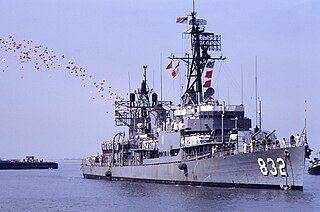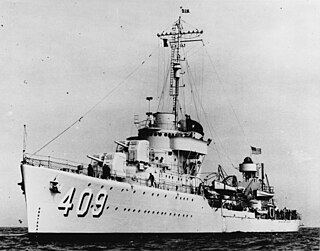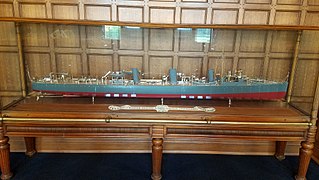
The Arleigh Burke class of guided missile destroyers (DDGs) is a United States Navy class of destroyer built around the Aegis Combat System and the SPY-1D multifunction passive electronically scanned array radar. The class is named for Admiral Arleigh Burke, an American destroyer officer in World War II, and later Chief of Naval Operations. The lead ship, USS Arleigh Burke, was commissioned during Admiral Burke's lifetime.

The Gearing class was a series of 98 destroyers built for the U.S. Navy during and shortly after World War II. The Gearing design was a minor modification of the Allen M. Sumner class, whereby the hull was lengthened by 14 ft (4.3 m) at amidships, which resulted in more fuel storage space and increased the operating range.

The Fletcher class was a class of destroyers built by the United States during World War II. The class was designed in 1939, as a result of dissatisfaction with the earlier destroyer leader types of the Porter and Somers classes. Some went on to serve during the Korean War and into the Vietnam War.

The Flower-class corvette was a British class of 294 corvettes used during World War II, specifically with the Allied navies as anti-submarine convoy escorts during the Battle of the Atlantic. Royal Navy ships of this class were named after flowers, hence the name of the class.

The Ticonderoga class of guided-missile cruisers is a class of warships in the United States Navy, first ordered and authorized in the 1978 fiscal year. The class uses passive phased-array radar and was originally planned as a class of destroyers. However, the increased combat capability offered by the Aegis Combat System and the AN/SPY-1 radar system, together with the capability of operating as a flagship, were used to justify the change of the classification from DDG to CG shortly before the keels were laid down for Ticonderoga and Yorktown.

The Sims-class destroyers were built for the United States Navy, and commissioned in 1939 and 1940. These twelve ships were the last United States destroyer class completed prior to the American entry into World War II. All Sims-class ships saw action in World War II, and seven survived the war. No ship of this class saw service after 1946. They were built under the Second London Naval Treaty, in which the limit on destroyer standard displacement was lifted, but an overall limit remained. Thus, to maximize the number of destroyers and avoid developing an all-new design, the Sims class were only 70 tons larger as designed than previous destroyers. They are usually grouped with the 1500-ton classes and were the sixth destroyer class since production resumed with the Farragut class in 1932.

The Allen M. Sumner class was a group of 58 destroyers built by the United States during World War II. Another twelve ships were completed as destroyer minelayers. The class was named for Allen Melancthon Sumner, an officer in the United States Marine Corps. Often referred to as simply the Sumner, this class was distinguished from the previous Fletcher class by their twin 5-inch/38 caliber gun mounts, dual rudders, additional anti-aircraft weapons, and many other advancements. The Allen M. Sumner design was extended 14 feet (4.3 m) amidships to become the Gearing class, which was produced in larger numbers but did not see significant service in World War II.

The Buckley-class destroyer escorts were 102 destroyer escorts launched in the United States in 1943–44. They served in World War II as convoy escorts and anti-submarine warfare ships. The lead ship was USS Buckley which was launched on 9 January 1943. The ships had General Electric steam turbo-electric transmission. The ships were prefabricated at various factories in the United States, and the units brought together in the shipyards, where they were welded together on the slipways.

The Captain class was the designation given to 78 frigates of the Royal Navy, constructed in the United States of America, launched in 1942–1943 and delivered to the United Kingdom under the provisions of the Lend-Lease agreement. They were drawn from two classes of the American destroyer escort classification: 32 of the GMT (Evarts) Type and 46 of the TE (Buckley) Type. Upon reaching the UK the ships were substantially modified by the Royal Navy, making them distinct from the US Navy destroyer escort ships.

The Porter-class destroyers were a class of eight 1,850-ton large destroyers in the United States Navy. Like the preceding Farragut-class, their construction was authorized by Congress on 26 April 1916, but funding was delayed considerably. They were designed based on a 1,850-ton standard displacement limit imposed by the London Naval Treaty; the treaty's tonnage limit allowed 13 ships of this size, and the similar Somers class was built later to meet the limit. The first four Porters were laid down in 1933 by New York Shipbuilding in Camden, New Jersey, and the next four in 1934 at Bethlehem Steel Corporation in Quincy, Massachusetts. All were commissioned in 1936 except Winslow, which was commissioned in 1937. They were built in response to the large Fubuki-class destroyers that the Imperial Japanese Navy was building at the time and were initially designated as flotilla leaders. They served extensively in World War II, in the Pacific War, the Atlantic, and in the Americas. Porter was the class' only loss, in the Battle of the Santa Cruz Islands on 26 October 1942.

The Bagley class of eight destroyers was built for the United States Navy. They were part of a series of USN destroyers limited to 1,500 tons standard displacement by the London Naval Treaty and built in the 1930s. All eight ships were ordered and laid down in 1935 and subsequently completed in 1937. Their layout was based on the concurrently-built Gridley class destroyer design and was similar to the Benham class as well; all three classes were notable for including sixteen 21 inch torpedo tubes, the heaviest torpedo armament ever on US destroyers. They retained the fuel-efficient power plants of the Mahan-class destroyers, and thus had a slightly lower speed than the Gridleys. However, they had the extended range of the Mahans, 1,400 nautical miles (2,600 km) farther than the Gridleys. The Bagley class destroyers were readily distinguished visually by the prominent external trunking of the boiler uptakes around their single stack.

The Rudderow-class destroyer escorts were destroyer escorts launched in the United States in 1943 to 1945. Of this class, 22 were completed as destroyer escorts, and 50 were completed as Crosley-class high speed transports and were re-classified as high speed transport APDs. One ship was converted to an APD after completion. They served in World War II as convoy escorts and anti-submarine warfare ships.

The C class as designated in 1913 was a heterogeneous group of torpedo boat destroyers (TBDs) built for the Royal Navy in the late-1890s. They were constructed to the individual designs of their builders to meet Admiralty specifications. The uniting feature of the class was a top speed of 30 knots, a "turtleback" forecastle and that they all had three funnels. The funnels were spaced equidistantly and were of equal height, but the central one was thicker.

Shinonome was the sixth of twenty-four Fubuki-class destroyers, built for the Imperial Japanese Navy following World War I. They served as first-line destroyers through the 1930s, and remained formidable weapons systems well into the Pacific War.

The Cannon class was a class of destroyer escorts built by the United States primarily for antisubmarine warfare and convoy escort service during World War II. The lead ship, USS Cannon, was commissioned on 26 September 1943 at Wilmington, Delaware. Of the 116 ships ordered, 44 were cancelled and six were commissioned directly into the Free French Forces. Destroyer escorts were regular companions escorting vulnerable cargo ships.

The Asashio-class destroyers were a class of ten destroyers of the Imperial Japanese Navy in service before and during World War II. The overall layout of the class proved successful in service and created a powerful ship that served as the basis for the design of the following two classes of destroyers.

HMS Violet was a Doxford three-funnel, 30-knot destroyer ordered by the Royal Navy under the 1896–1897 Naval Estimates. She was the seventh ship to carry this name since it was introduced in 1588 for a 200-ton vessel.

Akikaze was a Minekaze-class destroyer, built for the Imperial Japanese Navy immediately following the end of World War I. The Minekaze class of destroyers were considered advanced for their time; these ships served as first-line destroyers through the 1930s. The class was considered obsolete by the start of the Pacific War and served in a number of roles including minesweeper, aircraft rescue ships and Kaiten-carriers.

Tachikaze was a Minekaze-class destroyer, built for the Imperial Japanese Navy immediately following World War I. Advanced for their time, these ships served as first-line destroyers through the 1930s, but were considered obsolescent by the start of the Pacific War.

HMS Falcon was a Fairfield three-funnel, 30 knot destroyer ordered by the Royal Navy under the 1898 – 1899 Naval Estimates. She spent her life in Home waters, was part of the Dover Patrol during World War I and was lost in a collision on 1 April 1918.


















